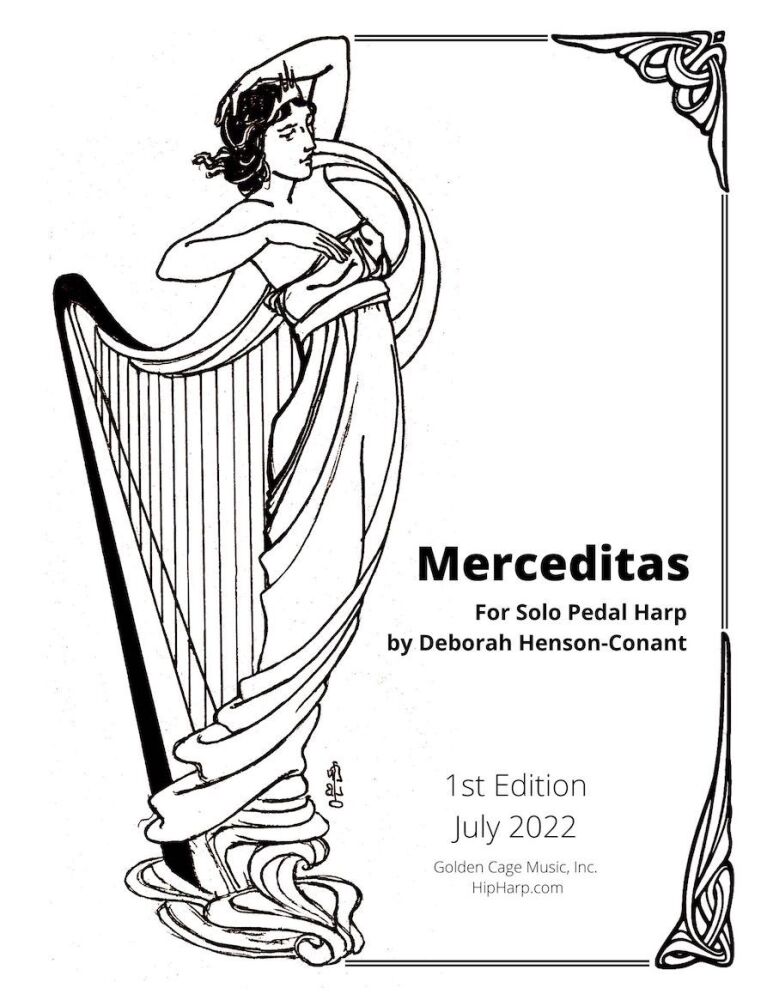
-
Merceditas - Deborah Henson-Conant
- Pedal Harp Solo
- £14.00

Standard: Intermediate to Advanced Harp Type: Pedal Harp
“Merceditas” is the most unabashedly romantic instrumental music I have ever written and is the companion piece to “Baroque Flamenco.” Played together with “Baroque Flamenco” it creates a bridge for the audience between the sound of a classical harp that they’re used to hearing, and the extended techniques of “Baroque Flamenco.”
Soñando en Español - Program Notes
Deborah Henson-Conant
"Merceditas" is the second movement of Soñando en Español , a three-movement Concerto for Concert Harp with Orchestra or Chamber Ensemble.
With the publication of this sheet music, "Merceditas" can now be performed with or without orchestral accompaniment. This movement may be performed together with 'Baroque Flamenco' or independently as a solo piece. Below are program notes for each movement of the concerto.
Soñando en Español (Dreaming in Spanish) is about a life deeply influenced by the music and rhythms of a culture outside your own, so much so that it becomes your own language.
Mvt I. My Mother’s Mexican Hat
Raised by a single mother, a young girl in California is thrilled to receive little presents every time her mother returns from a date. One evening, after a day-trip to Tijuana, Mexico her mother returns with an immense, handsome sombrero, only to tell her daughter that the magnificent hat must never be worn -- but she can hang it on her bedroom wall, with the strict instruction that she never touch it.
From that night on, the girl dreams in Spanish - a language she doesn’t speak - and is lulled to sleep by strange rhythms. One night, awakened by music, she discovers the hat, vibrant with light, and sliding from the wall. It takes her from her bed and together they dance a wild dance of joy and belonging in the moonlight.
The next night, and the next the same thing happens until - on the third night - her mother hears the music and rushes into the room, where she, too, falls under the spell of the Mexican hat. Dancing with both mother and child, the hat is so full of joy it flies out the window, never again to be seen – and yet it leaves behind its music in these two women who will dance forever to its rhythms.
Mvt II. Merceditas
The girl is now a young woman and has fallen shyly in love with a young grocer from Mexico who stacks fruit and vegetables by day -- and writes poetry by night. As an excuse to spend time with him, she asks if he’ll teach her to speak Spanish, and he agrees. He comes to her flat and they study in the kitchen, while in the next room, the girl’s roommate practices her harp. As music fills the kitchen, the lessons become a waltz. The waltz becomes romance. The kitchen becomes a ballroom, a lifetime, a dream - and in that dream, she blooms as a woman.
Mvt III. Baroque Flamenco
The young woman is now much older. The grocer and the hat are long-ago dreams - but both have filled her life with music, rhythm and romance. To live those rhythms the hat gave her, she’s joined a troupe of Flamenco dancers, and one day on the way to rehearsal, she discovers an unusual guitar in a used music shop. What she doesn’t know is that this guitar is a time machine and each strum she plays takes the entire troupe back in time. Enthralled with the instrument’s sound, she strums it so fast that the whole troupe finds itself in the court of Marie Antoinette, who is hosting a ball that night at which everyone is dancing the Minuet.
So the Flamenco dancers attempt to fit in.
Soon the stately Minuet is too constrained for this passionate troupe. They burst into rhythm - once, twice – each time subverting the courtly dancers - until finally Queen Marie herself steps onto the dance floor to challenge the dancers - and our girl strides up to meet her. Step by step she claims her own right to the rhythm, daring the Queen first with measured slaps of her dance shoes, and then with wilder and wilder strums of her guitar. Marie’s powdered-wig-wearing courtiers stare - first in silent horror and then so filled with passion that they, too, break onto the floor with abandon, dancing together until the Minuet and the Flamenco rhythms are one.
The “Baroque” theme in “Baroque Flamenco” is inspired by ‘Minuet in A Minor’ by Jean- Jacques Rousseau.
Notes: Deborah Henson-Conant